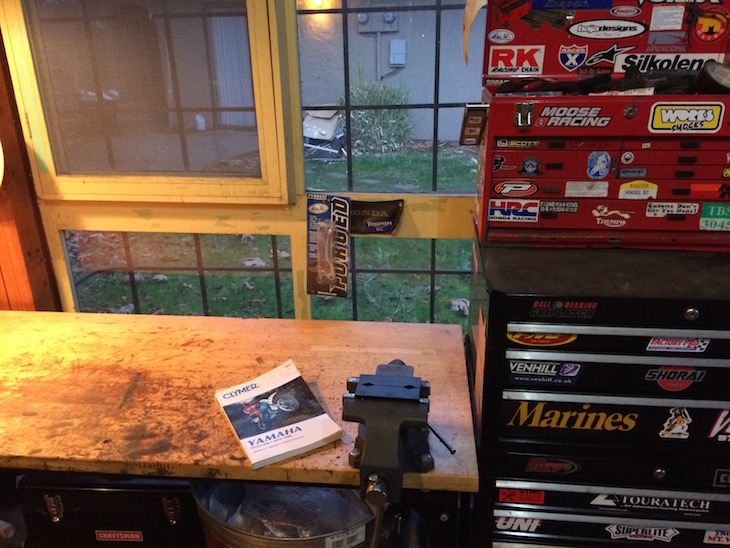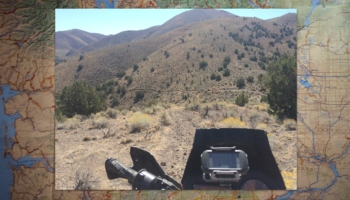Spinning Wrenches
Working on your own equipment is a great way to save a few bucks and better learn your machine for when something goes wrong on the trail. I started working on my own vehicles when I was 16 with my first car and haven’t looked back. At this point I have pretty much done it all, from minor servicing to full, ground-up restorations. In short my motorcycles don’t go to a mechanic, I am the mechanic. While my level of devotion to maintaining everything myself is not for everyone (and requires a dedicated, fully equipped workshop), I can provide some hard learned pointers to make it easier.

Buy Quality Tools
Tools are an investment, garbage will only cause you more pain. As a recreational mechanic you do not need to go out and buy a $5,000 set of Snap-On tools, but cheap tools I personally avoid. Craftsman, Husky, and Proto are all examples of affordable, easy to find, quality tools. While often not the choice of a profession mechanic, you will not be working forty or more hours a week with them. All of these brands have starter “mechanics sets” which are great value, even if some of the tools never get used. The reason for good tools is that cheap, poor quality tools, are often built to loose tolerances and tend to strip fasteners, and are uncomfortable to work with, and tend to break. You just saved a bunch of money by not paying the dealer to do a service, invest in tools you can pass down to your kids, and won’t need to buy again. While my toolbox has grown substantially since I was 16, many of my most used tools are the same ones that were part of the Craftsman “Mechanics Set” I got all of those years ago for Christmas.
Keep your tools organized
This might sound a bit OCD, but being able to find the right tool makes everything go smoother. My sockets are all on socket holders organized by size, my wrenches are in a wrench holder or tool roll and my screwdrivers are arranged by size in their own drawer. An organized toolbox, regardless of your system is very important. For years I worked on my bikes in parking lots and driveways out of a traditional style carry-toolbox (and still do at the racetrack), but was able to lay my wrench roll out and have my strip of organized sockets with a ratchet handy. A surgeon doesn’t cut into someone with a pile of scalpels on a tray, they are laid out, it just makes things easier. I tend to put everything back where it goes after taking something apart. That way, before I start reassembly, I don’t waste time trying to find the 10mm wrench again.
Buy a manual
We all like to joke that a real man doesn’t need a manual, but I am calling B.S. on that one. This isn’t a bookshelf, this is a motorcycle where a mis-installed part can wreak all sorts of havoc, and cause real danger to life and limb. I may often not have the manual open to the correct page, but it is always on the workbench when I need it. Having a guide on ‘what to do’ is more helpful than you might think, and a manual will give you that information. Many aftermarket accessories will refer you back to the manual for getting to the part you will be installing, or the torque specs.
Haynes and Clymer both offer great manuals for the shade-tree mechanic. They will often cover many like models and will be written for the guy (or gal) working on their own bike. The other option is the factory “shop manual,” this is what the mechanic at the dealership uses, they tend cost more and assume you are an experienced mechanic with a solid base of knowledge. I prefer shop manuals myself, but having both doesn’t hurt, you can never have too much information. Read and re-read the instructions before starting a job, both to familiarize yourself and make sure you aren’t going to need any tools you may not have.
Have a clean work area
It sounds like a bit of a no brainier, but it is easy to miss. Make sure you have plenty of space to lay out all of your parts. A cluttered work area can make it easy to lose things in the mess. Have good lighting, working in shadows just makes things easier to miss. If you have a garage invest in a workbench, and keep it clean.
Get a rolling stool and paddock stand
Every professional motorcycle mechanics bay has a motorcycle lift, having things at the right level makes them easier to work on. A rolling stool helps to comfortably bring you to the right level with the bike on the ground still. For $25-$50 you can get one, for me it was one of the better investments I have made in the garage. If your motorcycle does not have a center stand get a paddock stand like road-race teams use. This will let you work on the bike with it standing at a 90 degree angle. Access will be easier and the human brain can grasp a bolt going into a hole better at parallel to the ground than a random angle.
Allow yourself plenty of time
I have been guilty of not following this rule more times than I care to count. It is not fun to find yourself at 2am still getting your motorcycle ready for a race that starts at 9am. The book may say it takes two hours, your buddy might do the same job in a bit less, but if it is your first time give yourself plenty of time. I would say for new jobs double the time or add a few hours just to be safe. The “book” time is in a perfect world and in a factory workshop on a brand new motorcycle. Odds are your motorcycle has covered many miles, and a rounded out bolt (from the previous owner of course) can add a fair bit of time to deal with. There is the old saying “Haste makes waste,” if you budget too little time mistakes are more likely to happen. You can always sit on the couch with a beer if you finish early to kill some time.
Final Thoughts
Congratulations on your decision to do your own maintenance and services, or just to install some Touratech parts. While this was not an all inclusive guide to working on your own motorcycle (I’ll have to write a book for that) I hope I was able to give some tips to set you up for success. Remember, we would all love to have the immaculate, well lit garage with a lift and well stocked roll-away toolbox, but many jobs can be done almost as easily with much less. Good luck and have fun!
To read more of Archambault’s Angle CLICK HERE.
About the AuthorEric is an incurable motorcycle nut. He’s owned everything from scooters to vintage motocross bikes and now spends much of his time riding and talking about adventure motorcycles. If you have been to the Touratech store in Seattle or called the offices, chances are you’ve talked to Eric. Eric recently came in second place in the adventure class at the Desert 100 Race. He’s a key part of the Touratech race team and when he’s not at the local Harescramble or Enduro event he can be found roaming the Cascade mountains on his KTM 950 looking for new routes for the Touratech Rally.
